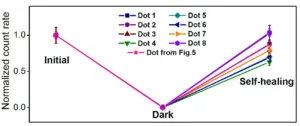Although colloidal lead halide perovskite quantum dots exhibit desirable emitter characteristics such as having high quantum yields and narrow bandwidths, up to now, instability has limited their application in devices. Work is going on to address this issue.

A team of researchers headed by Bo-Wei Hsu of the Department of Materials Science and Engineering, National Tsing Hua University (Hsinchu, Taiwan) and including team members from the Department of Chemistry of Northwestern University (Evanston, Illinois) and the Center for Nanoscale Materials at Argonne National Laboratory (Lemont, Illinois) is developing perovskite quantum emitter materials with high stability, self-healing ability and a fabrication method that is simple and economical.
To start, a few words of background information. Perovskite quantum dots can emit single photons at room temperature, have high quantum yield and high color purity. Such properties make these materials well suited for use in a variety of applications that include electronic displays. However, commercialization of perovskite quantum emitters has been hampered by lifetime issues….when strongly excited, this type of material is found to degrade after only a few minutes. Addressing this lifetime issue was one of the principle goals of the research undertaken by the team.
The team reported recent results of their research efforts in an article entitled “Very Robust Spray-Synthesized CsPbI3 Quantum Emitters with Ultrahigh Room-Temperature Cavity-Free Brightness and Self-Healing Ability.” The article was published on-line in ACS Nano on March 17, 2021. A copy of the article is available for purchase here.
In their article, the team explains that the most common method used for preparing perovskite quantum dots is to directly inject and mix two different solutions. By contrast, in their recent work, the team developed a spray-synthesis method which greatly increases the contact area between the two solutions. The new approach makes it possible to grow a uniform protective organic layer on the surface of the quantum dots. More specifically, the team worked with spray-synthesized CsPbI3 perovskite quantum dot emitter material. In the abstract of the article, the team reported several top level results from the study including that the new material was found to require only about 1% of the excitation intensity needed for other quantum emitters. In addition, the perovskite quantum dots provided high single photon emission rates, exceeding 9×106 photon counts per second (excluding multiexciton emissions) as well as strong photon anti-bunching. The purity of single photons was reported as quite high at 98%.
The new material displayed high brightness at room temperature. The performance of the material was stable over the course of 24 hours while being continuously excited by a high intensity laser. Based on extensive test and measurement data reported in the article, the researchers claim that the new material successfully overcomes the poor stability found in conventional perovskite quantum dots.
And….as an extra benefit: although the perovskite quantum dots are damaged and their emission does degrade with high intensity excitation, the new materials were found to recover their original brightness after “resting” for just a few minutes. Measurements indicated that the photoluminescence intensity of all materials recovered to greater than half of their initial values. In fact, half of the perovskite quantum dot materials recovered almost all of their initial photoluminescence intensity. This is illustrated in the figure below.
The count rate evolutions of eight spray-synthesized perovskite quantum dots. All of the spray-synthesized perovskite quantum dots exhibited self-healing behavior and restored their photoluminescence count rates to greater than half of their initial values.
The researchers attribute the robust properties of these spray-synthesized perovskite quantum dots to high crystallinity and good ligand encapsulation.
Based on the results of their work, the researchers close their article with the claim that
“The unprecedented single photon brightness of spray-synthesized perovskite quantum dots breaks the world record, which makes them become the brightest room temperature quantum emitter materials and constitute a major breakthrough in future quantum technologies.”
-Arthur Berman
Department of Materials Science and Engineering, National Tsing Hua University, Hao-Wu Lin, +886-3-5715131, [email protected]

